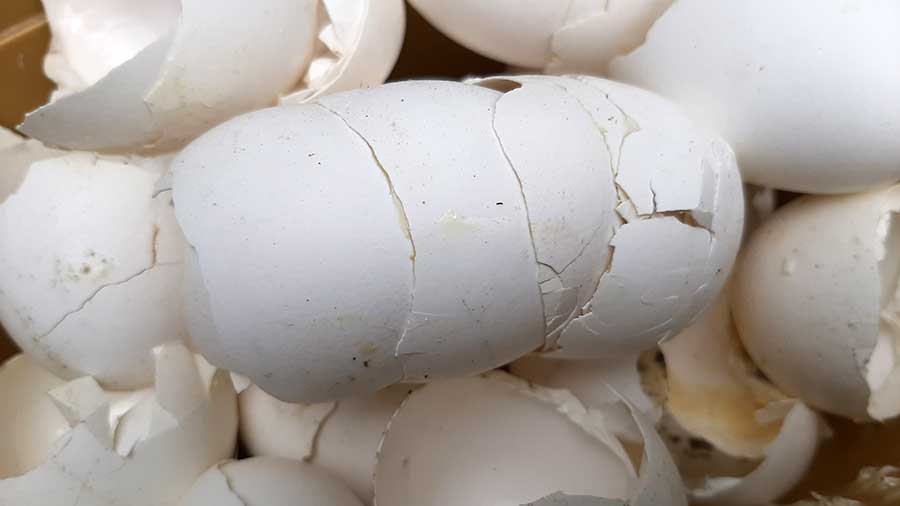Using eggshells is a good way to fertilize your potted plants or any other houseplant. The trick is knowing how to properly apply them to your plants.
There are many ways to apply eggshells as fertilizers but to really maximize their benefits, the nutrients and minerals from the eggshells must be absorbed by the plant immediately. The best way to use eggshells is by extracting its nutrients into a water-soluble mixture so it can be readily absorbed by the plants.
Eggshells are 95% calcium carbonate
I have done some research on what makes eggshells a good fertilizer and I found out that most good quality chicken eggshells contain approximately 2.2 grams of calcium in the form of calcium carbonate.
About 95% of the dry eggshell is calcium carbonate weighing 5.5 grams. Aside from calcium, the average eggshell also contains a small amount of phosphorus and magnesium.
Calcium prevents blossom end rot
Calcium is an important nutrient for any fruit-bearing plant such as tomatoes, peppers, cucumbers, and squash. Blossom end rot appears as a dark spot starting from the blossom end of a fruit. With an insufficient calcium supply, the dark, brownish spot, spreads slowly causing the fruit to dry out eventually while being deformed.
This is why it is just logical to use eggshells to supplement the calcium needs of a plant.
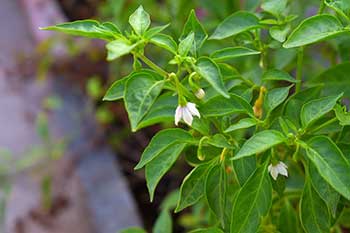
Aside from preventing blossom end rot, you may also have observed that the flowers of your tomato or pepper plant are constantly falling off. This is another case of calcium deficiency that needs to be addressed immediately.
Calcium needs to be extracted from the eggshells
I have read in some blogs that you can simply crush some eggshells and sprinkle them on or around the plant. I also read that you can mix in the crushed eggshells in your potting soil. This actually works but the problem is you have to wait for about 8-12 months before the plants can absorb the calcium!
For the calcium to be absorbed, the eggshells have to be broken down or decomposed first by exposing them to the acids in the soil. The lesser acid content in your soil, the longer it takes to decompose.
So how do shorten this process? The answer is to extract the calcium from the eggshells and make them water-soluble. What I usually do is to extract the calcium using vinegar as my acid. Now although I can prepare this in an hour, it still takes about 3 weeks to fully extract all the calcium in the eggshells.
How to use eggshells as fertilizer
I always make an eggshell fertilizer at home simply because of the seemingly endless supply of eggs in the kitchen. My end goal here is to make a water-soluble, calcium-rich fertilizer. Let me share this process with you. By making it water-soluble, the effect on plants will be instantaneous.
Step 1. Clean the eggshells
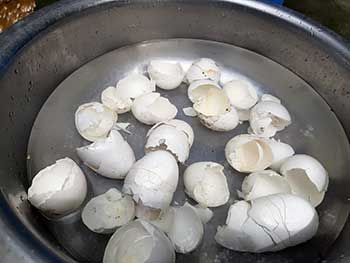
First, wash the eggshells properly. Remove all excess egg yolk and inner skin because it may contain contaminants or harmful bacteria that may damage the plants. Just place the eggshells in a basin full of water and brush away all dirt. Afterward, let it dry out in the sun.
Step 2. Heat the eggshells
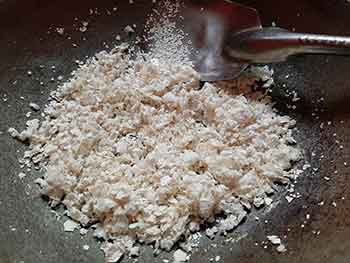
Crush the eggshells first before heating it. Next, we will heat the dried eggshells in a pan over low heat. We are going to stir it constantly until the color becomes brownish. Why do you need to heat the eggshells, you may ask? Well, it is not really necessary but if we will not heat it, we can only extract calcium.
Remember, there are also other nutrients found in the eggshells. If we heat it, we can also extract phosphorous. Phosphorous helps in the plant’s root development, which enables it to absorb nutrients efficiently. Do not burn or overcook the eggshell. The entire cooking process may last for 20 mins. Set aside and let it cool.
Step 3 Soak eggshells in vinegar
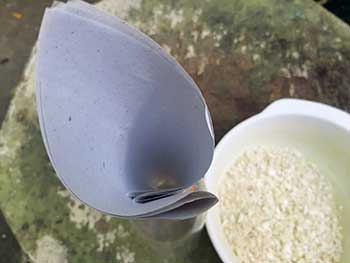
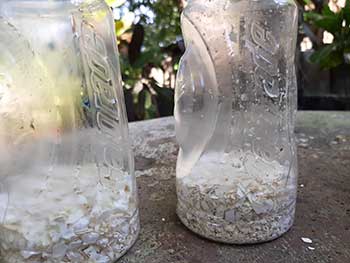
After it has cooled down, we are now ready to extract the calcium and phosphorus. To do this we need an acid. I just use vinegar as my acid. The vinegar I’m using is cane vinegar with 4.5% acidity. Any kind of vinegar will do as long as the acidity is 3% and above. Put the crushed eggshells in a container. I’m using those PET (polyethylene terephthalate) bottles they use in beverages.
Pour the vinegar into the container. The proper ratio is 1:9. For every 1 part of eggshells, use 9 parts vinegar. Do not cover it yet.
Step 4. Let the eggshells and vinegar react
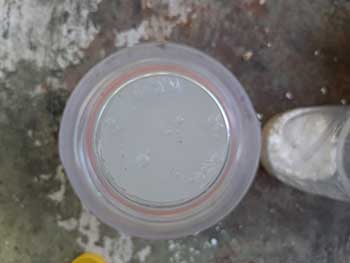
If you have followed the procedure correctly, the moment you pour in the vinegar, there will be an instant bubbling reaction. The acid in the vinegar is now slowly extracting the calcium and phosphorus from the eggshells.
This reaction could take a long time. It takes anywhere from 12-24 hours for the bubbling reaction to subside. During this time, just cover the container with tissue paper or any porous material. This is to prevent dirt or insects from the mixture and also to let the air by-product escape.
Once it subsides, you can now cover the container with a lid.
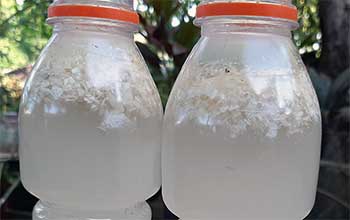
Step 5. Wait for 3-4 weeks
The entire extraction process may take anywhere from 20-30 days. While waiting, keep the solution in a cool and dry place away from direct sunlight. Uncover the lid once or twice a week to let the air escape.
Applying the eggshell fertilizer
Once the extraction process is complete, remove the undissolved particles using a strainer. You may also transfer the liquid into a new, clean container. To use this calcium-rich fertilizer, you have to dilute the solution first in water.
The ratio is 10 ml per liter of water. Or about 2 tablespoons per liter. Spray your fertilizer directly onto the leaves. This process of spraying liquid fertilizer is called foliar feeding.
Foliar feeding is a technique of feeding plants by applying liquid fertilizer directly to the leaves. Plants can absorb essential elements through their leaves. The absorption takes place through their stomata and also through their epidermis.
Do this once or twice a week. Most people forget this, but also spray under the leaves. As a tip, water early in the morning or late in the afternoon. The leaves absorb the nutrients better because at these times, the stomata, which are the tiny openings or pores in plant tissue that allow for gas exchange, are open.
With proper storage, this solution may last up to six months.
Use eggshells to repel slugs and snails
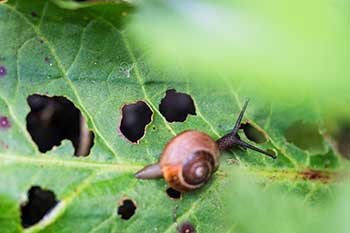
Do you know that aside from being a good fertilizer, eggshells can also serve as repellants for slugs and snails? Yes, as a bonus, these pests hate eggshells. It’s not really so much on the chemicals present in eggshells but it’s more on the texture.
Snails and slugs have a soft body that can easily be scratched or injured by a rough surface, such as crushed eggshells. Simply sprinkle some crushed eggshells around the plant to keep these pests from eating your plants.
Organic fertilizer for vegetative phase
Using this water-soluble eggshell fertilizer is great for the flowering or fruiting stage of a plant. It prevents the flowers from falling off the plant. However, when the plant is not yet producing flowers, it is considered to be in its vegetative phase. Meaning, it is still focusing on growing more leaves to produce food.
In this stage of the plant's life, the eggshell fertilizer may not be appropriate yet. Instead, it is better to use a fertilizer rich in nitrogen.
Nitrogen-rich organic fertilizer
One of my favorite ways to supply nitrogen to my plants is the grass clipping tea fertilizer. This organic fertilizer has been used by many gardeners and farmers for centuries. Aside from being free, it is also very easy to make. You can use grass, shrubs, or weeds you can find in your home.
Collect the clippings to fill half a bucket. Using a pair of scissors, cut the leaves to extract the juice. Place in a bucket or a deep container. Add water to fill the bucket to the top.
Cover with paper or cloth or any porous material. This is to avoid insects laying their eggs in the mixture. Do not use a solid or non-porous material to cover the bucket. Doing this will rapidly foul your mixture because of lack of air circulation. Let sit for 3-5 days.
Be sure to mix it daily for about 2-3 minutes before covering it again. To use, simply strain out the solid particles. Use it to water your plants about 2-3 times a week.


